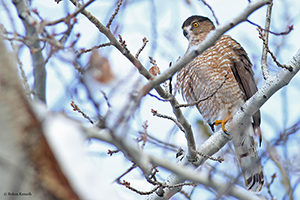 |
Sharp-shinned Hawk
Accipiter striatus |
|
|
STANFORD LOCATIONS: Fairly common visitor throughout campus from fall through spring, preying on small birds in virtually any habitat type. Unlike its larger congener the Cooper's Hawk, this species does not breed on campus. Similar Species:Cooper's Hawk. |
 |
Location |
Type |
Mating System |
Parental Care |
2ndary Diet |
Strategy |
|
|
|
|
I: 32-35 DAYS SEMIALTRICIAL 1 |
|
|
|
10 feet - 60 feet (10 feet - 90 feet) |
|
(3-8) MONOG |
MF |
| BREEDING: | n woodland, mountainous conif/decid forest. 1? brood. |
| DISPLAYS: | Courting pair circle, land in tree, and call; courtship often near nest. |
| NEST: | By trunk; broad and flat, of sticks, twigs. Lined with finer twigs, outer bark strips, grass, conif needles. Occ use old crow/squirrel nests, adding fresh materials. |
| EGGS: | White/bluish-white, marked with browns, wreathed. Occ unmarked; some clutches mixed. 1.5" (38 mm). |
| DIET: | Among accipiters, takes greatest proportion of birds as prey; only rarely takes small mammals, frogs, lizards, insects. |
| CONSERVATION: | Winters s through C.A. to c Panama, Greater Antilles. Blue List 1972-86; dramatic decline in e U.S. in early 1970s: 8% - 13% of eggs showed shell thinning. |
| NOTES: | Juveniles may comprise up to 60% of breeding females in some populations. Male does virtually all of hunting from incubation to early nestling stage. Young dependent on adults for 21-28 days postfledging. Often migrates in large numbers. |
| ESSAYS: | Wing Shapes and Flight; Blue List; Eye Color; Adaptations for Flight; Raptor Hunting; DDT. |
| REFERENCES: | Henny et al., 1985; Kerlinger and Lehrer, 1982; Platt, 1976; Reynolds and Meslow, 1984. |
| Help | Abbreviations | Species-Alphabetical | Species-Taxonomic | Essays-Alphabetical | |
| Except for Stanford Locations, the material in this species treatment is taken, with permission, from The Birder's Handbook (Paul Ehrlich, David Dobkin, & Darryl Wheye, Simon & Schuster, NY. 1988). | |||||